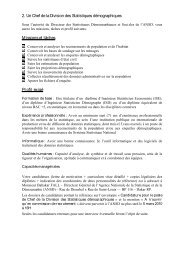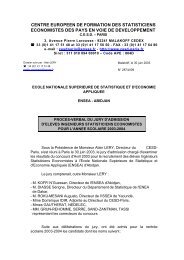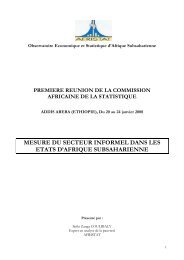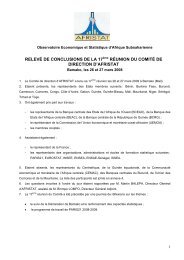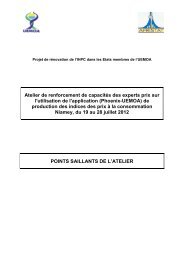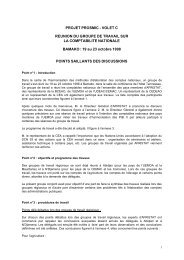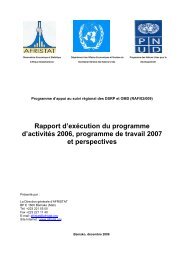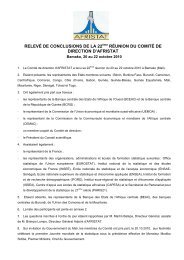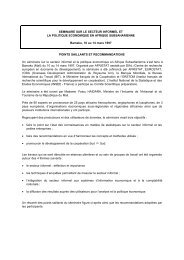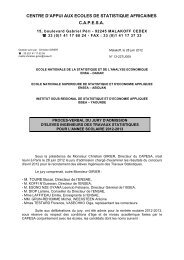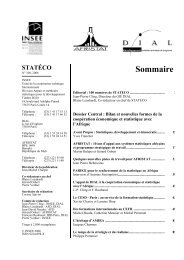Global Purchasing Power Parities and Real Expenditures - Afristat
Global Purchasing Power Parities and Real Expenditures - Afristat
Global Purchasing Power Parities and Real Expenditures - Afristat
You also want an ePaper? Increase the reach of your titles
YUMPU automatically turns print PDFs into web optimized ePapers that Google loves.
Methodology: Calculating PPPs 157The observed price data are in national currencies.Dummy variables with values of 1 or 0 are used to representeach country (i) <strong>and</strong> product (j). The regression coefficientsare estimated by ordinary least squares. The interdependentcountry factors (a i) are the PPPs relative to the base country,<strong>and</strong> the product factors (b j) are average prices in thebase country. If we assume that the base country is country1, then a i= 1. Any other country can be made the basecountry simply by dividing every country’s PPP by the newbase country’s PPP.Another useful output from the CPD model is a setof estimated prices in PPP terms, a ib j, for each product ineach country. Differences between observed prices <strong>and</strong> themodeled prices provide an indication of possible problemswith the prices provided by a country. Large differencesindicate that prices for the same product vary significantlybetween countries or that the product is misspecified or notrepresentative of the economy. The distribution of thesedifferences provides the underlying basis for the Dikhanovtable as an editing tool. The distributions can be graphedto provide a simple means of identifying potential problemprices, for a product across countries or for a set of productswithin a country.The EKS <strong>and</strong> EKS* MethodsThe EKS formula (named after its developers Éltetö, Köves,<strong>and</strong> Szulc) was first used to produce transitive PPPs from aset of nontransitive bilateral parities that were obtained assimple geometric averages from individual price ratios fora pair of countries. The EKS method differs from the CPDmethod in several important respects. First, it is based on abinary approach rather than a multilateral one. The binaryPPPs of all pairs of countries do not automatically producetransitive estimates, <strong>and</strong> hence an extra step is required toconvert the binary comparisons into multilateral, transitiveones. The EKS method treats participating countries as a setof independent units, each with an equal weight. The binaryPPPs are made transitive by a procedure that minimizes thedifferences between them <strong>and</strong> the multilateral PPPs it produces.For each pair of countries, the EKS method providesPPPs that are similar to the PPPs that would be obtained ifeach pair of countries had been compared separately.The EKS formula is used to produce transitive PPPsfrom a set of bilateral PPPs. If there are n countries in aregion, transitive PPPs are obtained as the nth root of theproduct of the direct bilateral PPP with weight 2 <strong>and</strong> (n–2)indirect PPPs, each with weight 1.For example, if there are three countries, A, B, <strong>and</strong> C,the transitive PPP for countries A <strong>and</strong> B is shown in equation(3):2P Ax 1P B P B P A(3)For the EKS formula to work, it is necessary for PPPsto be available for all countries for each basic heading.Occasionally, some PPPs for some countries were missingbecause of data collection problems or data consistencyissues. In such cases, PPPs had to be imputed either byusing the PPP of a similar basic heading or from a broader(but related) aggregate.The EKS method can be seen as a procedure that minimizesthe differences between multilateral binary PPPs <strong>and</strong>bilateral binary PPPs. In its most general form, it can bepresented in equation (4) asPPP j,k=Π PPP j,llxP CP BxPPP k,ll/m13P AP C(4)where PPP j,kis the multilateral index for country j <strong>and</strong>country k <strong>and</strong> m is the number of all countries.The EKS* method is an extension of the original EKSmethod; the asterisk (*) refers to the way in which theEurostat-OECD <strong>and</strong> the CIS denote representative productsin their PPP price collections. Each product deemedby a country to be representative of its expenditures isassigned an asterisk in a representativity field. Any productsthat do not have an asterisk in that field are treated asnonrepresentative.The starting point for EKS* is a comparison betweeneach pair of countries in a region. The issue of representative/nonrepresentativeproducts comes into play at thisstage. Three bilateral PPPs at the basic-heading level arecalculated for each pair of countries. A bilateral PPP is



